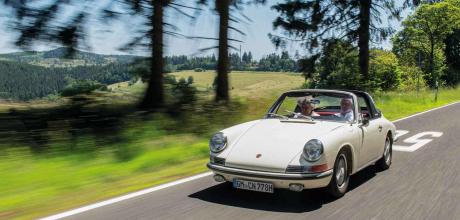1965 Porsche 911S Targa prototype
This unique Porsche 911 S Targa prototype was once the company car of motorsport legend Jochen Neerpasch. Time to reunite the two. Words Johan Dillen. Photography Dirk de Jager. Archive Jochen Neerpasch and Porsche AG.
MR TARGA'SMotorsport legend reunited with prototype
TARGA
NEERPASCH'S 911
Reuniting a Porsche legend with the prototype Targa he ran as a company car
Jochen Neerpasch is a legend in motor racing. He was the architect of Ford’s Touring Car success in Europe with the mighty Capris in the early 1970s. After switching to BMW, where he founded the Motorsport department, he made Porsche’s life difficult with the E9 CSL ‘Batmobile’, then conceived the M1, a car he still calls ‘my life work’.
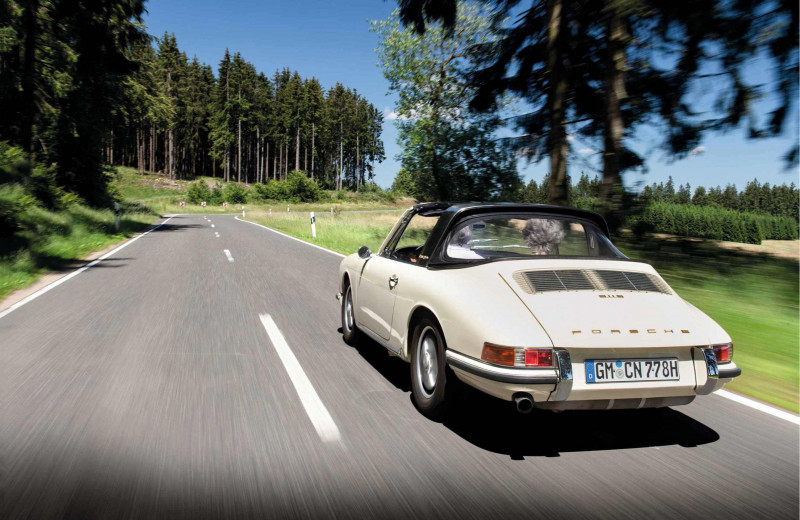
He was instrumental in getting Mercedes-Benz back into racing through the Sauber Group C initiative, before helping to push forward Michael Schumacher’s career by setting up the Mercedes Junior Team; even today, he manages BMW s equivalent. Which explains why he comes dressed in BMW battle gear to this reunion at the Nurburgring with what was his personal company car in 1967 and 1968. Just don’t expect an emotional outpouring from a man known for his stern character. ‘I have one hour. Lets go.’
Neerpaschs reputation as a driver is less well-known. Wrongly. He was among the first to drive a Shelby Daytona Coupe, at Le Mans in 1964, and shared a drive there with Jacky Ickx in a Ford GT40 in 1966. The following year, sharing a 911 R Sportomatic with Hans Herrmann and Vic Elford, he handed the Porsche works team a victory in the Marathon de la Route, a gruelling 84-hour race on the old Nurburgring. ‘1968 was my best year as a driver,’ Neerpasch remembers. ‘Victory at the Daytona 24 Hours in the Porsche 907, second at Sebring, and third place at Le Mans.’
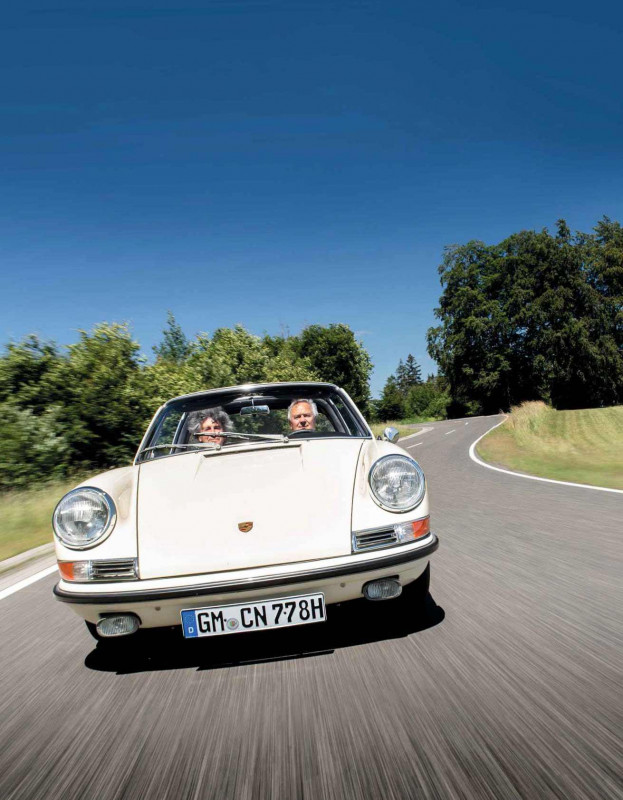
'It is a long time since I last heard the sound of an air-cooled flat-six. I love hearing that fan at work' JOCHEN NEERPASCH
Yet he felt his driving days were numbered. ‘I was 29 when this incredible offer came from Ford to start up its competitions department in Cologne. In those days, you could expect to make a living out of racing until you were 35, at most. And we had to live with the fact that every year we would lose three or four colleagues in deadly crashes. I’d had a big accident at Spa. That helped me make up my mind.’ But at the end of 1966, Neerpasch had been presented with a rather special courtesy car for his personal transport: this unique 911 S Targa prototype, The car is extraordinary, as its current caretaker explains. ‘It was a test car, run by the experimental department in Weissach,’ he says. ‘Porsche wanted to explore the possibilities of a more powerful 911 S version for the Targa. A lot of work went into preparing the car accordingly. During the restoration, we discovered extra reinforcements in the sills, to make sure the car would be up to the more sporting requirements.’
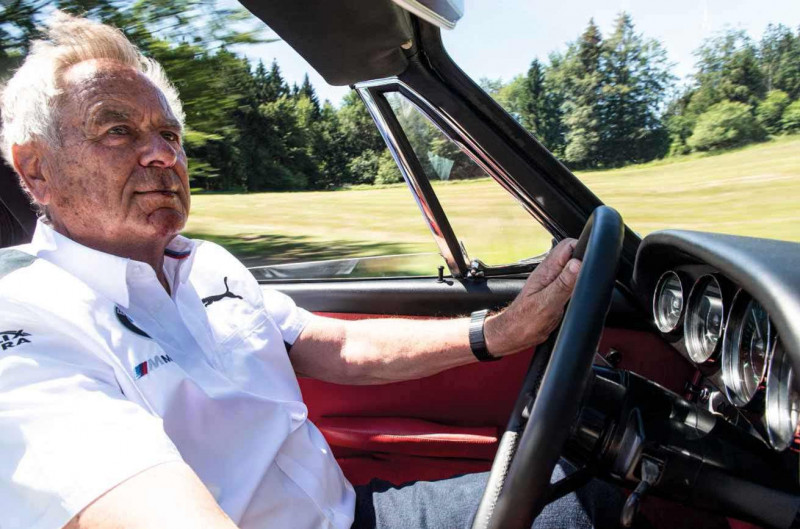
This car, chassis number 500 100, was built in 1965, two years before delivery of the first production Targa. In total, four prototypes for the 911 Targa are known: 500 001, 002, 003 and 100. The first three cars, regular 911 Targa models with the 130bhp engine, were unceremoniously crushed after testing duties had concluded, The only survivor was number 100, with a newly developed 160bhp engine, because it had a promotional role to play.
‘To test the waters for a 911 S Targa with the public,’ says its owner. ‘At the time, Porsche was happy to send out its best drivers with interesting cars to promote the brand. Uus, Porsche sent Jochen Neerpasch on his way with the company’s newest offering from the end of 1966. The first Targas were delivered to customers late in January 1967. When asked, he could say he was driving chassis 100, implying that 99 Targa S models had been built before.’
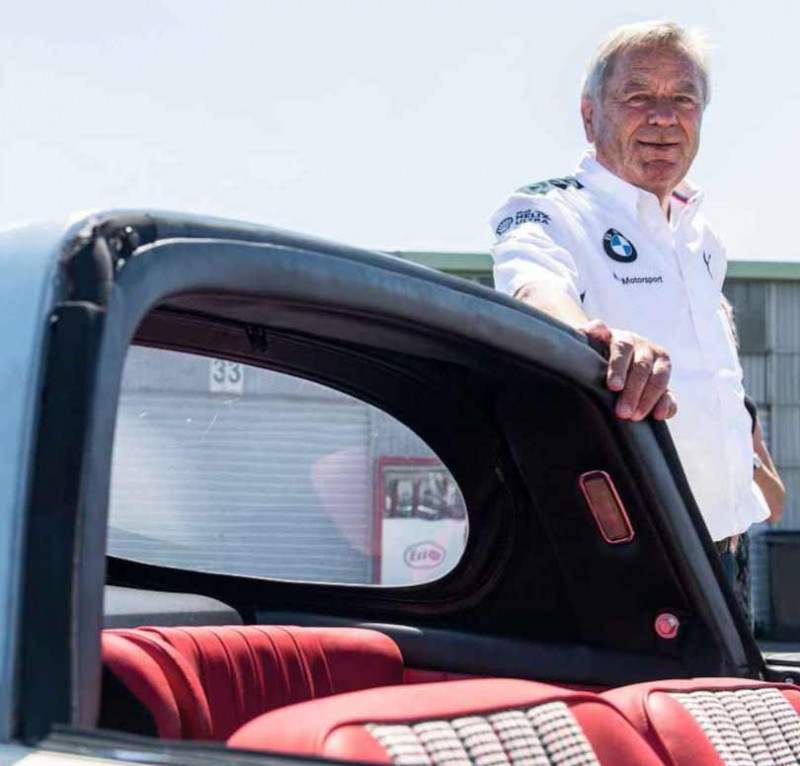
And there is more, ‘This car is equipped with what is now the oldest 911 engine known. It carries the casting stamp 900 054, preceding the 901 and 911 numberings. Porsche had set aside the engine series with the number 001 up to 099 for internal use. The block was cast in June 1965. It has red cam covers and comes equipped with triple Weber 40 IDS carburettors, pushing the 2.0-litre six-cylinder engine to 160bhp, 30bhp over the normal 2.0-litre you would find in the contemporary 911s. This set-up would later identify the 911 S. The transmission’s casting was produced in June 1965. It has no real serial number stamped, The number 11 indicates it was an experimental transmission.’
Between the summers of 1965 and 1966 this 911 S Targa was confined to testing duties at Weissach, and as the only known 911 S Targa prototype it was spared the crusher and prepared as a press car. ‘The interior was upgraded from experimental prototype to shiny press car, with a brushed aluminium inlay for the dashboard. In December 1966 it was registered with the numberplate S-YZ 26 and given to Jochen Neerpasch as his company car, but it was also used by journalists. In March 1967, Paul Frere took the car for a test, and had it serviced in Brussels, Belgium.’
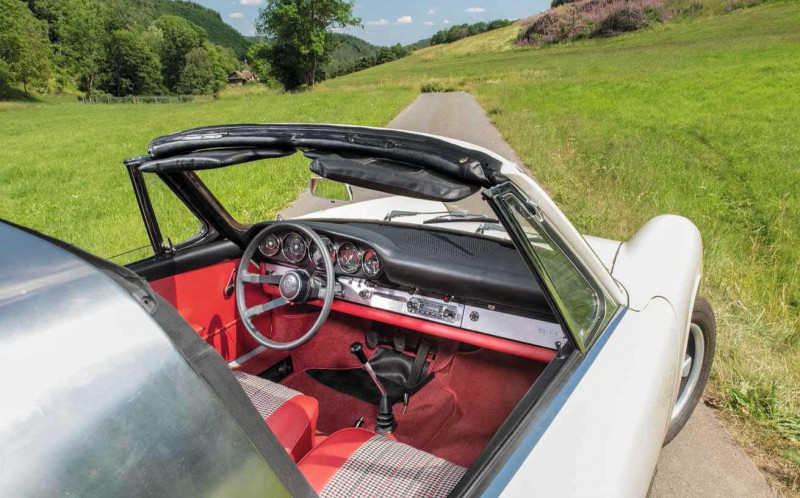
Almost the entire archive from the early days of the experimental department at Porsche under Dr Helmuth Bott was unfortunately lost after his death, and only one note remains: an order. ‘Each time the car was used, the keys needed to be handed over to the company’s dispatching unit, the Hausfahrdienst,’ says the owner. However, this car’s wildest adventure of 1967 has been documented by Neerpasch himself. It was sent to the Targa Florio, the infamous Sicilian road race that Porsche had won for the first time in 1956 and which gave this car its name. With its fixed roll-hoop a defining point, a ‘cabriolet’ nametag was out of the question. And what better way to promote the new car than by bringing the Targa to the Targa?
‘The car was shipped over from Stuttgart/ says Neerpasch. ‘I used it as my training car in the run-up to the race. We would train on the course for a full week, trying to memorise the 45-mile lap. It was tough for us circuit drivers to get the lap together in our heads. It was easier for guys like Vic Elford, who had a background in rallying. We would paint markers or place our own signs ahead of tricky situations, only to find in the race that our markers were overpainted or that spectators were standing in front of them.’

And the Targa was never easy. ‘During the training week, the roads were open to the public, so we’d encounter all kinds of traffic and obstacles on these tiny roads. I remember we were driving in a three-car convoy with the Porsche drivers one day, with Hans Herrmann leading. As the week went on, speeds increased. All of a sudden, Hans had a cow blocking his path. He couldn’t avoid the animal and hit it straight on. The next thing we knew, the farmer came running towards us, waving a rifle.’
Even so, Neerpasch enjoyed the experience — ‘It had such nice handling,’ he says — and the training certainly helped. Rolf Stommelen and Paul Hawkins brought home victory in a Porsche 910-8; Biscaldi and Cello were second in a 910¬6; Neerpasch and Elford took the third podium spot in another 910-6. The Targa Florio became a hunting ground for Porsche, its drivers establishing a winning streak that ran uninterrupted from 1966 to 1971.
Neerpasch liked the ivory-coloured (Elfenbein) 911 S Targa so much that in September 1967 he bought it privately. It wasn’t until he got the Ford contract — and the AC Cobra company car that came along with it — that he sold it on. After which its history is unknown until 1983.
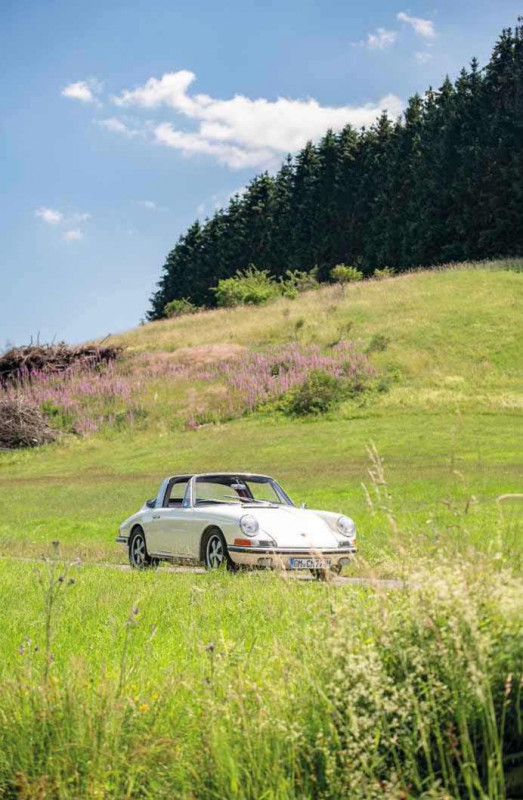
‘That year, Barney Alacorn from Santa Cruz did a paint- job for Merritt, the owner of the biggest scrapyard in the region,’ says the Targa’s owner. ‘Instead of getting paid, Merritt made Alacorn an offer: “Pick any car you like.” From the line of cars ready to be scrapped, he picked this one. He repainted it in blue and black. In 1989, he sold the car to a restorer who had planned to dismantle it for parts. Fortunately, he never got round to that over the next 25 years, when someone showed up and bought it from him. This car has escaped death three times.’
The current owner came across the 911 S Targa at an auction during Monterey Car Week in 2014. ‘It wasn’t even listed in the catalogue. My wife pointed to it, standing anonymously in the background. And during the auction, bidding stopped short of the seller’s expectations.’
And so it was listed as unsold, with several questions raised. ‘It was offered as a 911 S, but the chassis number was missing the S that would put it in 1968 production. Something wasn’t quite right, probably the reason why people were put off by it. But one sentence in the catalogue gave me the feeling that it might be a bit special. It read “vom Versuch geliefert” — “delivered by the Experimental Department”. So I made the owner an offer. He accepted.’ The car was kept in the US at first, and stripped by a shop in Tucson, Arizona, ‘The body was in poor shape; we had to replace a lot of sheet metal. And we uncovered the efforts Porsche had made to reinforce the car, including four extra beams in the sills, to improve rigidity, The roof was also different from that of the production Targas, with extra reinforcement. And it was clear that Porsche wanted this thing to handle. It weighs just 2270lb [1030kg], which is identical to the1965 911 Coupe.’
Inside, the seats had been covered with black leatherette; the original upholstery was underneath but impossible to save. ‘We recreated new leather to the original specification, The leather of the original steering wheel was rotten as well. A life-long upholsterer for Porsche at the factory created a more modern replacement.’
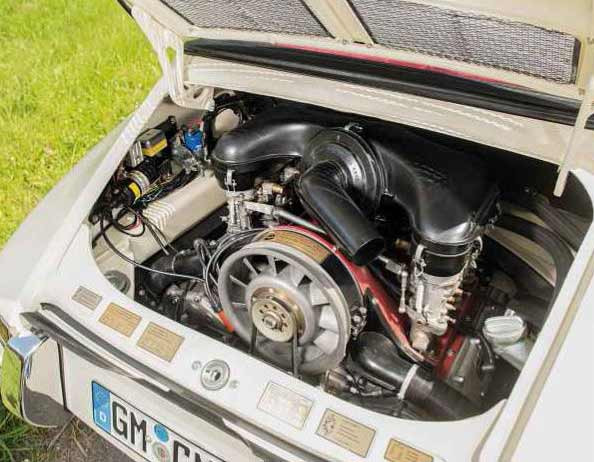
While the body gave little reason for optimism, the mechanical parts told a different story. ‘We opened up the engine and the gearbox. It looked great and we found nice details, like the initials “LL” — sometimes proud workers would leave their mark in the form of an unofficial stamping, These are probably the initials of the person who put this engine together. Both the engine and the gearbox are still 100% original, There was only 21,000km on the clock when we got the car. We renewed the pistons, the chain tensioner and otherworn parts and cleaned everything else.’ With no clear idea of its past from Porsche’s archives, the owner set out on a series of interviews. ‘I tried to get hold of everyone who worked at the Experimental Department in 1965 and 1966. Not one conversation led to a breakthrough, but each time I got snippets of new information, until finally it all came together. Porsche’s official photographer, Werner Eisele, was a big help in piecing the puzzle together.’
Now, for the first time in over half a century, we bring this car and its famous owner together once more. Here, in the old paddock at the Nurburgring, it looks exactly as Neerpasch last saw it in 1968. The man himself is clearly touched: happy to talk, but the tone of his voice is quiet, and he chooses his words carefully. He’s keen to get behind the wheel: ‘It is a long time since I last heard the sound of an air- cooled flat-six. I love hearing that fan at work.’
Neerpasch is savouring every minute behind the wheel. At first he happily complies with the photographer’s orders, but as we chase the Porsche for the rear shot there’s a change in his behaviour, The speed picks up, the line through the corner gets tighter. Clearly, the man has still got it.
Later, he tells us: ‘This is all so light and reactive to drive — I like that feeling. I just don’t remember the seats being set this high. And the steering wheel, it’s a bit too big now.’ Asked why he bought the Targa from Porsche, Neerpasch waves at the open air. ‘This: the Targa feeling, That made it special for me.’ And with that he leaves us, still far from ready for retirement. A bit like his car, really. Two of a kind.
TECHNICAL DATA 1965 Porsche 911S Targa prototype
- Engine 1990cc air-cooled flat-six, OHC per bank, triple Weber 40 IDS carburettors
- Max Power 160bhp @ 6600rpm
- Max Torque 132lb ft @ 5200rpm
- Transmission Five-speed manual, rear-wheel drive
- Steering Rack and pinion
- Suspension Front: MacPherson struts, torsion bars, anti-roll bar. Rear: trailing arms, torsion bars, telescopic dampers, anti-roll bar
- Brakes Discs
- Weight 1030kg
- Top speed 137mph
- 0-60mph 8.0sec
Below and right Neerpasch enjoys once more the open-air sensations of driving a Targa; original-style leather was used to retrim the interior, and the steering wheel was restored by a life-long Porsche worker.

Above and below Neerpasch took his 911 S Targa to the Targa Florio in 1967 as a training car in which to learn the route the week before the race; he finished third in this 910-6, seen here with his co-driver, Vic Elford
Left and right Jochen Neerpasch, the former Porsche works racer, reunited with his old company car for the first time since 1968.


